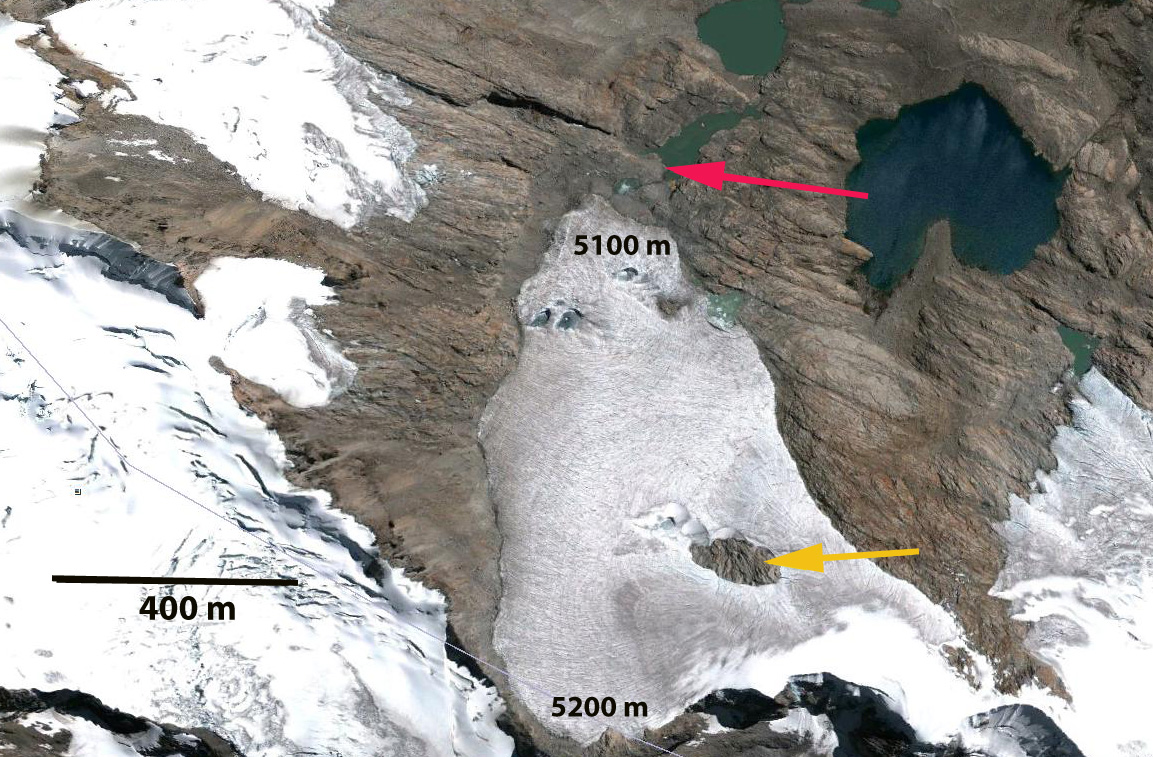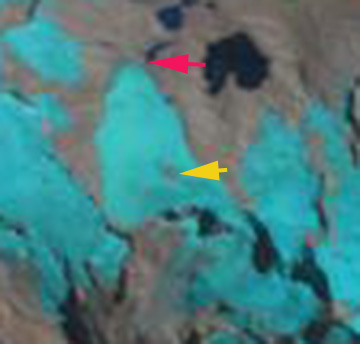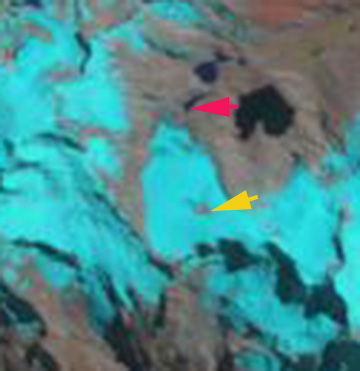January 19, 2013
Corihuasi East Glacier Retreat, Peru
Posted by Mauri Pelto
In the Cordillera Centrale of Peru a series of glaciers extends north from Pariacaca. Pariacaca is the pre-Incan god of water, appropriate name in this dry region, that is draped with glaciers and has numerous alpine lakes. On the north side of Pariacaca Mountain is the Corihuasi East Glacier. The Corihuasi Glacier has been retreating and has developed a number of holes that penetrate the glacier to its bedrock base. The retreat of this glacier is similar to that of Manon Glacier and Chuecon Glacier in this same mountain range. The glacier flows northeast beginning at 5200 meters and ending at 5100 meters. The glacier is 1.3 km long and has an area of 0.8 square kilometers in 2010.  This post examines Landsat imagery from 1998, 2005, 2011 and 2012 and Google Earth imagery from 2010, shown in that order below. The red arrow in each image indicates the 1998 terminus location which ended in a lake. The yellow arrow indicates the location of a bedrock exposure amidst the glacier that will develop and enlarge. By 2005 the glacier has retreated from the lake, 110 meters from 1998 and the bedrock exposure is evident. In 2011 and 2012 the glacier has retreated 200 meters from the 1998 position and the bedrock exposure has greatly expanded. The Google Earth imagery has much better resolution. The size of the bedrock exposure is 230 meters by 100 meters. What is of greater concern for the survival of this glacier is the development of a number of holes in the glacier that reach the glacier base, at the yellow arrows. There is a clear depression extending west from the main bedrock exposure to another depression reaching the glacier bed, this will allow expansion of the main bedrock exposure from 230 m to 400 m. In each case once bedrock at a glacier base is exposed this will speed up melting of the surrounding ice and demise of this glacier. This glacier will not survive current climate because in many years such as 1998 and 2010 the glacier has lost all its snowcover indicating a glacier that does not have a persistent accumulation zone. Without a persistent accumulation a glacier cannot survive. (Pelto, 2010).
This post examines Landsat imagery from 1998, 2005, 2011 and 2012 and Google Earth imagery from 2010, shown in that order below. The red arrow in each image indicates the 1998 terminus location which ended in a lake. The yellow arrow indicates the location of a bedrock exposure amidst the glacier that will develop and enlarge. By 2005 the glacier has retreated from the lake, 110 meters from 1998 and the bedrock exposure is evident. In 2011 and 2012 the glacier has retreated 200 meters from the 1998 position and the bedrock exposure has greatly expanded. The Google Earth imagery has much better resolution. The size of the bedrock exposure is 230 meters by 100 meters. What is of greater concern for the survival of this glacier is the development of a number of holes in the glacier that reach the glacier base, at the yellow arrows. There is a clear depression extending west from the main bedrock exposure to another depression reaching the glacier bed, this will allow expansion of the main bedrock exposure from 230 m to 400 m. In each case once bedrock at a glacier base is exposed this will speed up melting of the surrounding ice and demise of this glacier. This glacier will not survive current climate because in many years such as 1998 and 2010 the glacier has lost all its snowcover indicating a glacier that does not have a persistent accumulation zone. Without a persistent accumulation a glacier cannot survive. (Pelto, 2010). 






 Dean of Academic Affairs at Nichols College and Professor of Environmental Science at Nichols College in Massachusetts since 1989. Glaciologist directing the North Cascade Glacier Climate Project since 1984. This project monitors the mass balance and behavior of more glaciers than any other in North America.
Dean of Academic Affairs at Nichols College and Professor of Environmental Science at Nichols College in Massachusetts since 1989. Glaciologist directing the North Cascade Glacier Climate Project since 1984. This project monitors the mass balance and behavior of more glaciers than any other in North America.